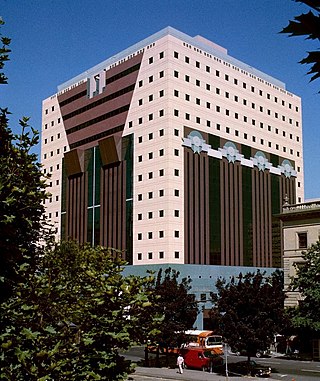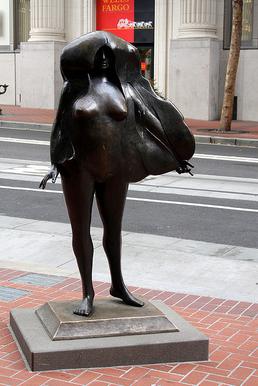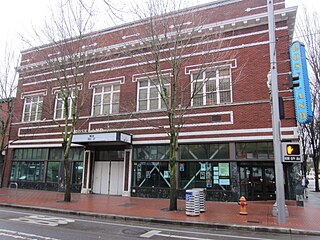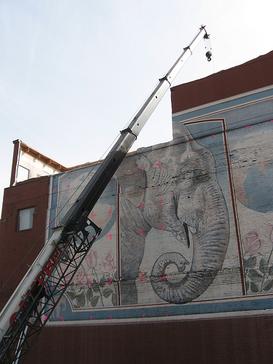
Portland is a port city in the Pacific Northwest and the most populous city in the U.S. state of Oregon. Situated in the northwestern area of the state at the confluence of the Willamette and Columbia rivers, Portland is the county seat of Multnomah County, the most populous county in Oregon. As of 2020, Portland had a population of 652,503, making it the 26th-most populated city in the United States, the sixth-most populous on the West Coast, and the second-most populous in the Pacific Northwest, after Seattle. Approximately 2.5 million people live in the Portland metropolitan statistical area, making it the 25th most populous in the United States. About half of Oregon's population resides within the Portland metropolitan area.

The Portland Building, alternatively referenced as the Portland Municipal Services Building, is a 15-story municipal office building located at 1120 SW 5th Avenue in downtown Portland, Oregon. Built at a cost of US$29 million, it opened in 1982 and was considered architecturally groundbreaking at the time.

Governor Tom McCall Waterfront Park is a 36.59-acre (148,100 m2) park located in downtown Portland, Oregon, along the Willamette River. After the 1974 removal of Harbor Drive, a major milestone in the freeway removal movement, the park was opened to the public in 1978. The park covers 13 tax lots and is owned by the City of Portland. The park was renamed in 1984 to honor Tom McCall, the Oregon governor who pledged his support for the beautification of the west bank of the Willamette River—harkening back to the City Beautiful plans at the turn of the century which envisioned parks and greenways along the river. The park is bordered by RiverPlace to the south, the Steel Bridge to the north, Naito Parkway to the west, and Willamette River to the east. In October 2012, Waterfront Park was voted one of America's ten greatest public spaces by the American Planning Association.

The Skidmore Fountain is a historic fountain in Portland, Oregon, United States.

The South Park Blocks form a city park in downtown Portland, Oregon. The Oregonian has called it Portland's "extended family room", as Pioneer Courthouse Square is known as Portland's "living room".

Keller Fountain Park is a city park in downtown Portland, Oregon. Originally named Forecourt Fountain or Auditorium Forecourt, the 0.92-acre (0.37 ha) park opened in 1970 across Third Avenue from what was then Civic Auditorium. In 1978, the park was renamed after Ira C. Keller, head of the Portland Development Commission (PDC) from 1958 to 1972. Civic Auditorium was renamed as Keller Auditorium in 2000, but is named in honor of Ira's son, Richard B. Keller.

The Cornelius Hotel is a hotel building in downtown Portland, Oregon, United States that is listed on the National Register of Historic Places. It was designed by John V. Bennes's firm, and constructed in 1907–08. Its original period of use as a hotel had ended by the 1950s. A fire in 1985 left the top three floors uninhabitable. By the early 1990s the building had been vacated, and it then stood out of use for more than two decades. In 2016–2018, it was joined to the adjacent Woodlark Building, extensively renovated, and converted into a hotel. Named Woodlark House of Welcome, the hotel was scheduled to open on December 15, 2018.

William Sumio Naito was an American businessman, civic leader and philanthropist in Portland, Oregon, U.S. He was an enthusiastic advocate for investment in downtown Portland, both private and public, and is widely credited for helping to reverse a decline in the area in the 1970s through acquiring and renovating derelict or aging buildings and encouraging others to invest in downtown and the central city.

Kvinneakt is an abstract bronze sculpture located on the Transit Mall of downtown Portland, Oregon. Designed and created by Norman J. Taylor between 1973 and 1975, the work was funded by TriMet and the United States Department of Transportation and was installed on the Transit Mall in 1977. The following year Kvinneakt appeared in the "Expose Yourself to Art" poster which featured future Mayor of Portland Bud Clark flashing the sculpture. It remained in place until November 2006 when it was removed temporarily during renovation of the Transit Mall and the installation of the MAX Light Rail on the mall.

Allow Me, also known as Umbrella Man, is a 1983 bronze sculpture by John Seward Johnson II, located in Pioneer Courthouse Square in Portland, Oregon, United States. The sculpture, one of seven Allow Me casts, was donated anonymously to the City of Portland in 1984 for display in the Square. It depicts a life-sized man dressed in a business suit, hailing a cab and holding an umbrella. Constructed from bronze, aluminum and stainless steel, the sculpture stands six feet, ten inches tall and weighs 460 pounds. The sculpture is one of many works of art generated by the city's Percent for Art program, and is considered part of the City of Portland and Multnomah County Public Art Collection courtesy of the Regional Arts & Culture Council.

The Quest, sometimes referred to as Saturday Night at the Y or Three Groins in a Fountain, is an outdoor marble sculpture and fountain designed by Count Alexander von Svoboda, located in Portland, Oregon in the United States. The sculpture, carved in Italy from a single 200-ton block of white Pentelic marble quarried in Greece, was commissioned by Georgia-Pacific in 1967 and installed in front of the Standard Insurance Center in 1970. It depicts five nude figures, including three females, one male and one child. According to the artist, the subjects represent man's eternal search for brotherhood and enlightenment.

The Roseland Theater, sometimes called the Roseland Theater and Grill, is a music venue located at 8 Northwest Sixth Avenue in the Old Town Chinatown neighborhood of Portland, Oregon, in the United States. The building was originally a church, constructed by the Apostolic Faith Church in 1922. In 1982, Larry Hurwitz converted the building to a music venue called Starry Night. In 1990, the club's 21-year-old publicity agent was murdered in one of the theater's hallways; Hurwitz was convicted for this murder ten years later. Hurwitz sold the club in 1991, claiming he had lost support from the local music industry. The venue was given its current name during the 1991 ownership transfer. During the 1990s, Double Tee acquired control of the hall's operations, then purchased and renovated the building.

The Gypsy Restaurant and Velvet Lounge was a restaurant and nightclub established in 1947 and located along Northwest 21st Avenue in the Northwest District neighborhood of Portland, Oregon, in the United States. Popular with young adults, the restaurant was known for serving fishbowl alcoholic beverages, for its 1950s furnishings, and for hosting karaoke, trivia competitions, and goldfish racing tournaments. The restaurant is said to have influenced local alcohol policies; noise complaints and signs of drunken behavior by patrons made the business a target for curfews and closure. Concept Entertainment owned the restaurant from 1992 until 2014 when it was closed unexpectedly.

Thompson Elk Fountain, also known as the David P. Thompson Fountain, David P. Thompson Monument, Elk Fountain, the Thompson Elk, or simply Elk, is a historic fountain and bronze sculpture by American artist Roland Hinton Perry. The fountain with its statue was donated to the city of Portland, Oregon, United States, in 1900 for display in Downtown Portland's Plaza Blocks. It is owned by the City of Portland.

The Chiming Fountain, also known as Cupid's Fountain, the John Staehli Fountain, Portland's City Park Fountain and Washington Park Fountain, is an outdoor cast iron fountain and sculpture built in 1891 by John "Hans" Staehli. It is installed in Washington Park in Portland, Oregon, United States. The fountain's name derives from the sound made when water drips from the upper basin. Staehli designed the fountain to serve as a watering trough for horses pulling carriages into the park. Based on a Renaissance fountain, it was originally painted white and included a statuette of a boy, possibly depicting Cupid, though the figure was damaged and permanently removed from the sculpture before or during the 1940s.

A bronze sculpture of American pioneer, newspaper editor and historian Harvey W. Scott (1838–1910) by Gutzon Borglum, sometimes called Harvey Scott or Harvey W. Scott, was installed on Mount Tabor in Portland, Oregon, United States, until being toppled in October 2020.

The Packy mural was a public artwork depicting the elephant of the same name, painted on the Skidmore Fountain Building in Portland, Oregon's Old Town Chinatown neighborhood. The artwork was designed by Eric Larsen and painted in 1990 by North Pacific Sign and Design, but was destroyed during the building's 2008 renovation to become the new headquarters for Mercy Corps.
The Theodore Roosevelt Memorial is a lost monument and sculpture commemorating the 26th president of the United States, Theodore Roosevelt, as well as veterans of the Spanish–American War. It was originally installed in Portland's Battleship Oregon Park. Designed by American artist Oliver L. Barrett, the 18-foot (5.5 m) memorial was erected in 1939, but disappeared in 1942 after being relocated temporarily during the construction of Harbor Drive. It featured a geometric tufa statue depicting a man not resembling Roosevelt, as well as a smaller realistic sculpture of him. The monument initially received a generally unfavorable reception, but was considered one of Barrett's best-known artworks.




















